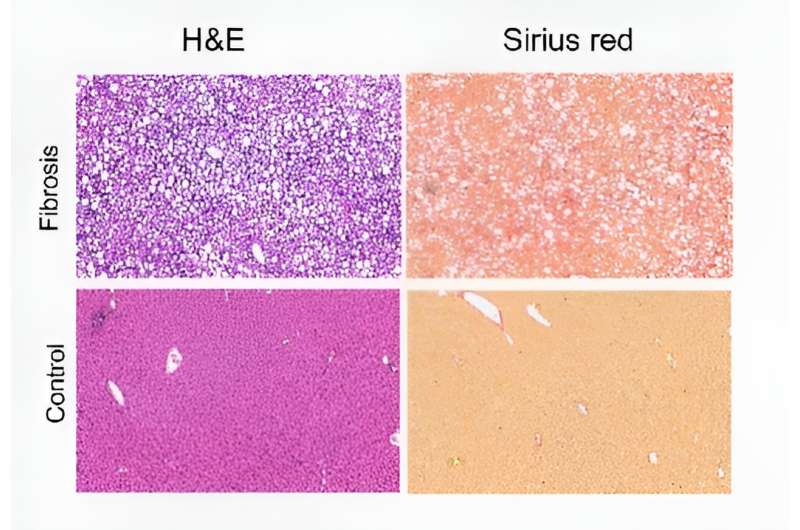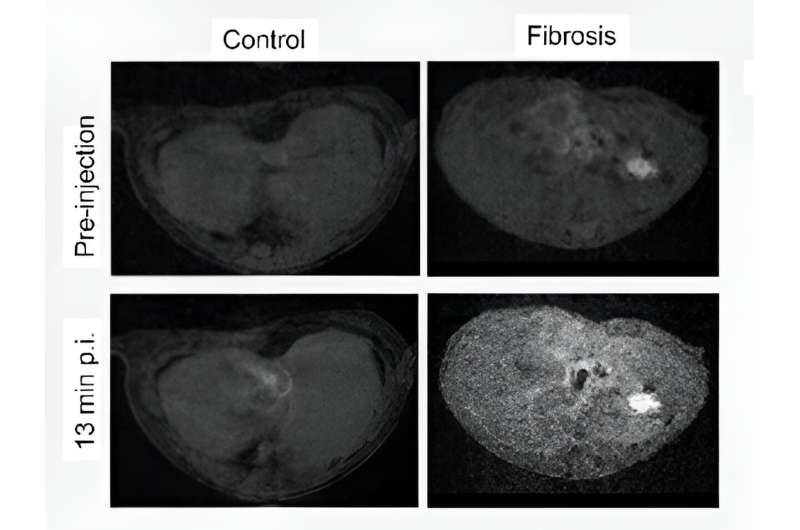This article has been reviewed according to Science X's editorial process and policies. Editors have highlighted the following attributes while ensuring the content's credibility:
fact-checked
peer-reviewed publication
trusted source
proofread
Targeted MRI detects chronic liver disease

Chronic liver diseases such as hepatitis, liver cirrhosis, and hepatocellular carcinoma are a major cause of morbidity and mortality worldwide. Fibrosis—the thickening and scarring of connective tissue—plays a major role in these liver diseases but detection of fibrosis is limited to biopsy, which suffers from limitations including the risk of complications, sampling only a tiny fraction of the liver, and an inability to serially monitor disease progression due to its invasive nature.
To provide better diagnosis and treatment of chronic liver diseases, researchers are working to use non-invasive magnetic resonance imaging (MRI) to detect and quantify liver fibrosis throughout the entire organ, which would enable earlier detection and the ability to monitor disease progression as well as the effects of treatment over time.
Adapting MRI for detecting chronic conditions such as fibrosis involves the development of tissue-specific MRI contrast agents that target diseased tissue such as the collagen that accumulates in fibrotic liver. To develop such agents, researchers have been challenged to design and synthesize compounds that must find and bind the tissue target, provide a strong signal under MRI, and rapidly clear from the system to minimize any toxicity.
Now a research team led by Moungi G. Bawendi, Ph.D., at the Massachusetts Institute of Technology and Peter Caravan, Ph.D., at the Massachusetts General Hospital has developed a nanoparticle-based contrast agent with the properties necessary to successfully use MRI for targeted diagnosis of liver fibrosis.
The team includes researchers from the Institute for Innovation in Imaging at Massachusetts General Hospital and Harvard Medical School and scientists at Collagen Medical in Boston. The study is published in the journal Proceedings of the National Academy of Sciences.

"This work addresses an unmet clinical need for a non-invasive diagnostic to detect fibrosis that develops in a number of liver disorders," explained Guoying Liu, Ph.D., director of the program in magnetic resonance imaging at the National Institute of Biomedical Imaging and Bioengineering (NIBIB), which supported the study. "The team has engineered a compound that meets the exacting specifications needed to accelerate potential use of this type of imaging agent in the clinic."
The new contrast agent is called a single nanometer iron oxide collagen-binding peptide (SNIO–CBP), which describes the two distinct functional parts of the molecule. SNIO is a single nanometer (very small) iron oxide molecule that provides very high contrast that can be easily detected with MRI. CBP is the part of the nanoparticle construct that targets and binds to the collagen in fibrotic tissue in the liver.
The small size of the particle allows it to move out of the bloodstream and into tissues where the targeting component of the particle—CBP—attaches to the collagen found in fibrotic liver and therefore avoids non-specific binding to healthy tissues. The iron oxide has the desired effect of changing the magnetic environment of surrounding protons, providing a strong signal to create an image with MRI.
The team tested SNIO–CBP in two mouse models which resemble toxin- and diet-induced human liver fibrosis. The results were extremely promising with SNIO–CBP providing a robust collagen-specific image in both mouse models of fibrosis. Importantly, the images were obtained 15 minutes after administration into the bloodstream, which was extremely rapid compared to other similar experimental agents that took hours to days to accumulate in the target tissue and provide an MRI image, which precludes practical use in the clinic.
SNIO–CBP also had favorable characteristics in terms of low background signal in surrounding normal liver tissue as well as rapid kidney clearance. Rapid clearance from the system reduces any potential toxicities of the contrast agent, which is particularly important in patients with liver or kidney disease.
"This compound successfully combines superior magnetic characteristics needed for a strong MRI signal with rapid, specific accumulation in the target tissue," explained Bawendi. "We now have a molecular platform for synthesizing tissue-specific MRI contrast agents, which is a major step toward adding a highly valuable non-invasive diagnostic tool for chronic liver disease that will be applicable to a wide range of other diseases, as well."
More information: Juanye Zhang et al, Fast detection of liver fibrosis with collagen-binding single-nanometer iron oxide nanoparticles via T 1 -weighted MRI, Proceedings of the National Academy of Sciences (2023). DOI: 10.1073/pnas.2220036120




















